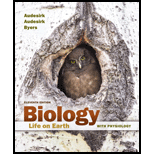
Concept explainers
To design:
A mosquito trap or killer that uses the innate behavior of both the mosquito and moth trap.
Introduction:
The high-pitched whine of female mosquito attracts male mosquitoes and the only blood-sucking sex in mosquitoes is female which are attracted to humidity, carbon dioxide, and warmth released by the prey. This is the innate behavior of both the male and female mosquitoes which can be used to design a mosquito trap.
Explanation of Solution
A trap can be designed which is comprised of humidified chamber. Carbon dioxide can be pumped into the chamber continuously and the temperature of the chamber can be maintained by using a thermostat and setting the temperature to
Along with such conditions, a device producing an equal frequency whining sound can be placed inside the chamber, which will attract the male mosquitoes. As the mosquitoes will hit the trap, they will be killed by the
The female moths produce a chemical named bombykol pheromone which attracts male moths. The antennae of male moths have pheromone-binding proteins. A plant named Honeysuckle can be used to attract female moths. A trap can be designed containing a Honeysuckle plant and electrically live wires. The females will get attracted towards the plant and will die after getting struck with electric current. A device can be inserted which releases bombykol like chemical to which males will get attracted and will be killed by striking the electrically live wire.
A trap can be constructed with humidified chamber having a thermostat and a device producing equal frequency of whining sound. The carbon dioxide can be pumped continuously. The female mosquitoes will get attracted towards humidity, carbon dioxide, and temperature and the male will get attracted to whine. An electrically live wire can be placed to kill mosquitoes.
Female moths are attracted to Honeysuckle plant and the males are attracted to the bombykol pheromone released by females. A trap can be designed which contains a Honeysuckle plant, electrically live wires, and a device emitting bombykol like a pheromone. Males will get attracted to bombykol, whereas the female will get attracted to plant and both will get killed after striking electrically live wire.
Want to see more full solutions like this?
Chapter 26 Solutions
Biology: Life on Earth with Physiology (11th Edition)
- Using quail and chick embryos, quail-specific antibody and fluorescent tissue-specific antibodies, design an experiment where you investigate the tissues the cranial neural crest can give rise to. What are four derivatives of the cranial neural crest that you expect to see in the resulting chimeric embryos?arrow_forwardDoes the neural crest have to undergo epithelial to mesenchymal transition prior to migration through the developing embryo? Does the neural crest differentiate into different cell types based on their axial position along the anterior and posterior axis?arrow_forwardUsing quail and chicken embryos, what kind of experiment would you conduct to test if rib forming somites have their axial identity specified before segmentation? How do we know this phenotype is due to axial identity being specified before segmentation and not due to our experimental method?arrow_forward
- 8. Aerobic respiration of a 5 mM solution of tripeptide that is composed of the following three amino acids; alanine, leucine and isoleucine. Alanine breaks down to pyruvate, leucine breaks down to Acetyl-CoA and isoleucine breaks down to succinyl-CoA. Alanine NADH FADH2 OP ATP SLP ATP Total ATP Leucine Isoleucine Totals Show your work using dimensional analysis here: 4arrow_forward9. Aerobic respiration of one lipid molecule. The lipid is composed of one glycerol molecule connected to two fatty acid tails. One fatty acid is 12 carbons long and the other fatty acid is 18 carbons long in the figure below. Use the information below to determine how much ATP will be produced from the glycerol part of the lipid. Then, in part B, determine how much ATP is produced from the 2 fatty acids of the lipid. Finally put the NADH and ATP yields together from the glycerol and fatty acids (part A and B) to determine your total number of ATP produced per lipid. Assume no other carbon source is available. fatty acids glycerol 18 carbons 12 carbons 0=arrow_forwardinfluences of environment on the phenotype.arrow_forward
- What is the difference between codominance and phenotypic plasticity?arrow_forwardExplain the differences between polygeny and pleiotropy,arrow_forwardIf using animals in medical experiments could save human lives, is it ethical to do so? In your answer, apply at least one ethical theory in support of your position.arrow_forward
- You aim to test the hypothesis that the Tbx4 and Tbx5 genes inhibit each other's expression during limb development. With access to chicken embryos and viruses capable of overexpressing Tbx4 and Tbx5, describe an experiment to investigate whether these genes suppress each other's expression in the limb buds. What results would you expect if they do repress each other? What results would you expect if they do not repress each other?arrow_forwardYou decide to delete Fgf4 and Fgf8 specifically in the limb bud. Explain why you would not knock out these genes in the entire embryo instead.arrow_forwardYou implant an FGF10-coated bead into the anterior flank of a chicken embryo, directly below the level of the wing bud. What is the phenotype of the resulting ectopic limb? Briefly describe the expected expression domains of 1) Shh, 2) Tbx4, and 3) Tbx5 in the resulting ectopic limb bud.arrow_forward
 Biology Today and Tomorrow without Physiology (Mi...BiologyISBN:9781305117396Author:Cecie Starr, Christine Evers, Lisa StarrPublisher:Cengage Learning
Biology Today and Tomorrow without Physiology (Mi...BiologyISBN:9781305117396Author:Cecie Starr, Christine Evers, Lisa StarrPublisher:Cengage Learning
 Biology: The Dynamic Science (MindTap Course List)BiologyISBN:9781305389892Author:Peter J. Russell, Paul E. Hertz, Beverly McMillanPublisher:Cengage Learning
Biology: The Dynamic Science (MindTap Course List)BiologyISBN:9781305389892Author:Peter J. Russell, Paul E. Hertz, Beverly McMillanPublisher:Cengage Learning Biology (MindTap Course List)BiologyISBN:9781337392938Author:Eldra Solomon, Charles Martin, Diana W. Martin, Linda R. BergPublisher:Cengage Learning
Biology (MindTap Course List)BiologyISBN:9781337392938Author:Eldra Solomon, Charles Martin, Diana W. Martin, Linda R. BergPublisher:Cengage Learning Concepts of BiologyBiologyISBN:9781938168116Author:Samantha Fowler, Rebecca Roush, James WisePublisher:OpenStax College
Concepts of BiologyBiologyISBN:9781938168116Author:Samantha Fowler, Rebecca Roush, James WisePublisher:OpenStax College





